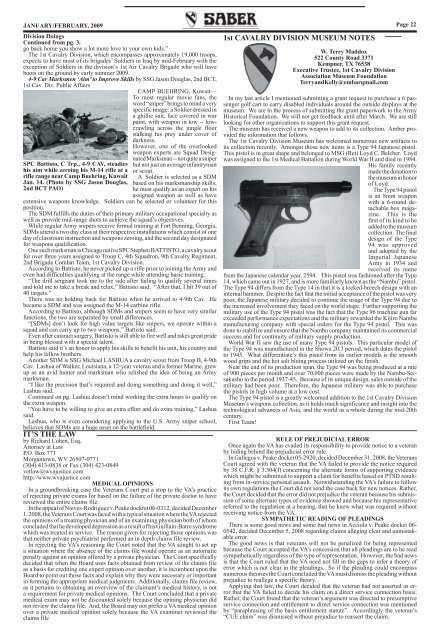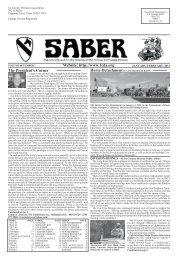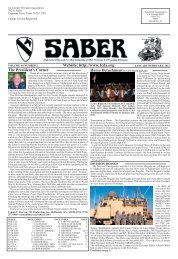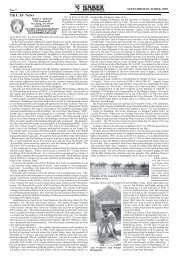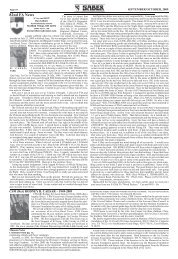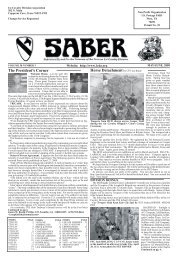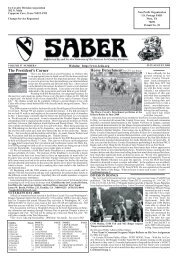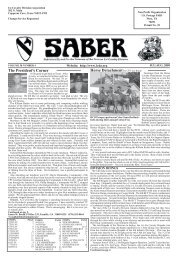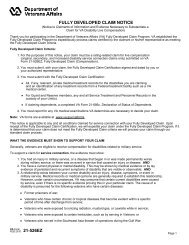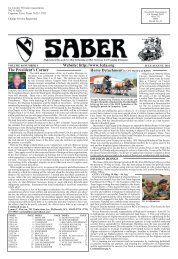Jan Feb '09 Saber.indd - First Cavalry Division Association
Jan Feb '09 Saber.indd - First Cavalry Division Association
Jan Feb '09 Saber.indd - First Cavalry Division Association
- No tags were found...
You also want an ePaper? Increase the reach of your titles
YUMPU automatically turns print PDFs into web optimized ePapers that Google loves.
JANUARY/FEBRUARY, 2009SPC Battisto, C Trp., 4-9 CAV, steadieshis aim while zeroing his M-14 rifle at arifle range near Camp Buehring, Kuwait<strong>Jan</strong>. 14. (Photo by SSG Jason Douglas,2nd BCT PAO)<strong>Division</strong> DoingsContinued from pg. 3.go back home you show a lot more love to your own kids.”The 1st <strong>Cavalry</strong> <strong>Division</strong>, which encompasses approximately 19,000 troops,expects to have most of its brigades’ Soldiers in Iraq by mid-<strong>Feb</strong>ruary with theexception of Soldiers in the division’s 1st Air <strong>Cavalry</strong> Brigade who will haveboots on the ground by early summer 2009.4-9 Cav Marksmen ‘Aim’ to Improve Skills by SSG Jason Douglas, 2nd BCT,1st Cav. Div. Public AffairsCAMP BUEHRING, Kuwait—To most regular movie fans, theword “sniper” brings to mind a veryspecific image: a Soldier dressed ina ghillie suit, face covered in warpaint, with weapon in tow -- lowcrawlingacross the jungle floorstalking his prey under cover ofdarkness.However, one of the overlookedweapon experts are Squad DesignatedMarksman -- not quite a sniperbut not just an average infantrymanor scout.A Soldier is selected as a SDMbased on his marksmanship skills;he must qualify as an expert on hisassigned weapon as well as haveextensive weapons knowledge. Soldiers can be selected or volunteer for thisposition.The SDM fulfills the duties of their primary military occupational specialty aswell as provide mid-range shots to achieve the squad’s objectives.While regular Army snipers receive formal training at Fort Benning, Georgia,SDMs attend a two day class at their respective installations which consist of oneday of classroom instruction and weapons zeroing, and the second day designatedfor weapons qualification.One such marksman is Chicago native SPC Stephen BATTISTO, a cavalry scoutfor over three years assigned to Troop C, 4th Squadron, 9th <strong>Cavalry</strong> Regiment,2nd Brigade Combat Team, 1st <strong>Cavalry</strong> <strong>Division</strong>.According to Battisto, he never picked up a rifle prior to joining the Army andeven had difficulties qualifying at the range while attending basic training.“The drill sergeant took me to the side after failing to qualify several timesand told me to take a break and relax,” Battisto said. “After that, I hit 39 out of40 targets.”There was no holding back for Battisto when he arrived to 4-9th Cav. Hebecame a SDM and was assigned the M-14 carbine rifle.According to Battisto, although SDMs and snipers seem to have very similarfunctions, the two are separated by small differences.“[SDMs] don’t look for high value targets like snipers, we operate within asquad and can carry up to two weapons,” Battisto said.Even after cataract surgery, Battisto is still able to fire well and takes great pridein being blessed with a special talent.Battisto said it’s an honor to apply his skills to benefit his unit, his country andhelp his fellow brothers.Another SDM is SSG Michael LASHUA a cavalry scout from Troop B, 4-9thCav. Lashua of Walker, Louisiana, a 12-year veteran and a former Marine, grewup as an avid hunter and marksman who relished the idea of being an Armymarksman.“I like the precision that’s required and doing something and doing it well,”Lashua said.Continued on pg. Lashua doesn’t mind working the extra hours to qualify onthe extra weapon.“You have to be willing to give an extra effort and do extra training,” Lashuasaid.Lashua, who is even considering applying to the U.S. Army sniper school,believes that SDMs are a huge asset on the battlefield.IT’S THE LAWby Richard Cohen, Esq.Attorney at LawP.O. Box 771Morgantown, WV 26507-0771(304) 413-0838 or Fax (304) 423-0849vetlaw@wvajustice.comhttp://www.wvajustice.comMEDICAL OPINIONSIn a groundbreaking case the Veterans Court put a stop to the VA’s practiceof rejecting private exams for based on the failure of the private doctor to havereviewed the entire claims file.In the appeal of Nieves-Rodriguez v. Peake dockret 06-0312, decided December1, 2008, the Veterans Court was faced with a typical situation where the VA rejectedthe opinions of a treating physician and of an examining physician both of whomconcluded that he developed depression as a result of his Guillain-Barre syndromewhich was treated in service. The reason given for rejecting those opinions wasthat neither private psychiatrist performed an in depth claims file review.In rejecting the VA’s reasoning the Court noted that the VA sought to set upa situation where the absence of the claims file would operate as an automaticpenalty against an opinion offered by a private physician. The Court specificallydecided that when the Board uses facts obtained from review of the claims fileas a basis for crediting one expert opinion over another, it is incumbent upon theBoard to point out those facts and explain why they were necessary or importantin forming the appropriate medical judgments. Additionally, claims file review,as it pertains to obtaining an overview of the claimant’s medical history, is nota requirement for private medical opinions. The Court concluded that a privatemedical exam may not be discounted solely because the opining physician didnot review the claims file. And, the Board may not prefer a VA medical opinionover a private medical opinion solely because the VA examiner reviewed theclaims file1st CAVALRY DIVISION MUSEUM NOTESW. Terry Maddox522 County Road 3371Kempner, TX 76538Executive Trustee, 1st <strong>Cavalry</strong> <strong>Division</strong><strong>Association</strong> Museum FoundationTerryandKelly@embarqmail.comPage 22In my last article I mentioned submitting a grant request to purchase a 6 passengergolf cart to carry disabled individuals around the outside displays at themuseum. We are in the process of submitting the grant paperwork to the ArmyHistorical Foundation. We will not get feedback until after March. We are stilllooking for other organizations to support this grant request.The museum has received a new weapon to add to its collection. Amber providedthe information that follows.The 1st <strong>Cavalry</strong> <strong>Division</strong> Museum has welcomed numerous new artifacts toits collection recently. Amongst those new items is a Type 94 Japanese pistol.This pistol is in great shape and belonged to MSG (Ret) Loyd C. Belcher. Loydwas assigned to the 1st Medical Battalion during World War II and died in 1984.His family recentlymade the donation tothe museum in honorof Loyd.The Type 94 pistolis an 8mm weaponwith a 6-round detachablebox magazine.This is thefirst of its kind to beadded to the museumcollection. The finaldesign of the Type94 was approvedand adopted by theImperial JapaneseArmy in 1934 andreceived its namefrom the Japanese calendar year, 2594. This pistol was fashioned after the Type14, which came out in 1927, and is more familiarly known as the “Nambu” pistol.The Type 94 differs from the Type 14 in that it is a locked-breech design with aninternal hammer. Despite the fact that the initial acceptance of the pistol was verypoor, the Japanese military decided to continue the usage of the Type 94 due tothe increased involvement they faced on the world stage. Further supporting themilitary use of the Type 94 pistol was the fact that the Type 96 machine gun farexceeded performance expectations and the military rewarded the Kijiro Nambumanufacturing company with special orders for the Type 94 pistol. This wasdone to stabilize and ensure that the Nambu company maintained its commercialsuccess and for continuity of military supply production.World War II saw the use of many Type 94 pistols. This particular model ofthe Type 94 was manufactured in the Showa 20.3 period, which dates the pistolto 1945. What differentiate’s this pistol from its earlier models is the smoothwood grips and the hot salt bluing process utilized on the finish.Near the end of its production span, the Type 94 was being produced at a rateof 900 pieces per month and over 70,000 pieces were made by the Nambu-Seisakushoin the period 1937-45. Because of its unique design, sales outside of themilitary had been poor. Therefore, the Japanese military was able to purchasethe pistols in high volume at a low cost.The Type 94 pistol is a greatly welcomed addition to the 1st <strong>Cavalry</strong> <strong>Division</strong>Museum’s weapons collection, as it holds much significance and insight into thetechnological advances of Asia, and the world as a whole during the mid-20thcentury.<strong>First</strong> Team!RULE OF PREJUDICIAL ERROROnce again the VA has evaded its responsibility to provide notice to a veteranby hiding behind the prejudicial error rule.In Gallegos v. Peake docket 05-2920, decided December 31, 2008, the VeteransCourt agreed with the veteran that the VA failed to provide the notice requiredby 38 C.F.R. § 3.304(f) concerning the alternate forms of supporting evidencewhich might be submitted to support a claim for benefits based on PTSD resultingfrom in-service personal assault. Notwithstanding the VA’s failure to followits own regulations the Court did not send the case back for new notices. Rather,the Court decided that the error did not prejudice the veteran because his submissionof some alternate types of evidence showed and because his representativereferred to the regulation at a hearing, that he knew what was required withoutreceiving notice from the VA.SYMPATHETIC READING OF PLEADINGSThere is some good news and some bad news in Acciola v. Peake docket 06-0542, decided December 5, 2008 regarding claims alleging clear and unmistakableerror.The good news is that veterans will not be penalized for being representedbecause the Court accepted the VA’s concession that all pleadings are to be readsympathetically regardless of the type of representation. However, the bad newsis that the Court ruled that the VA need not fill in the gaps to infer a theory oferror which is not clear in the pleadings. So if the pleading could encompassnumerous theories the Court concluded the VA must dismiss the pleading withoutprejudice to reallege a specific theory.Applying that law, the Court decided that the veteran had not asserted as errorthat the VA failed to decide his claim on a direct service connection basis.Rather, the Court found that the veteran’s argument was directed to presumptiveservice connection and entitlement to direct service connection was mentionedby “paraphrasing of the basis entitlement statute”. Accordingly the veteran’s“CUE claim” was dismissed without prejudice to reassert the claim.


